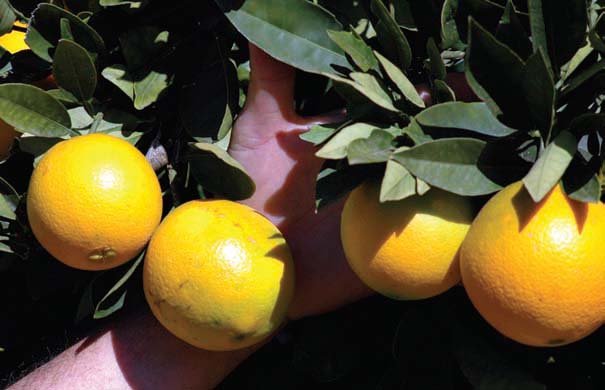
Case
Study
Location
Ellerslie, New South Wales
Crop
Citrus
Palinyewah Producers, Ellerslie NSW
The manager of a leading Sunraysia citrus orchard is convinced that a biological approach represents a safer, more cost-efficient and sustainable method of horticultural production than conventional fertiliser programs.
According to Peter Donaldson, who has managed Palinyewah Producers, for more than 25 years, the biological nutrition program he adopted five years ago is directly responsible for a significant improvement in tree and soil health and improved quality, yield and consistency.

BioAg Horticulturalist, Marco Retamoza, and Palinyewah Producers manager, Peter Donaldson.
Owned by Keith and Jan Richards, Palinyewah Producers is located near the village of Ellerslie, 35km north of Wentworth. The 47ha orchard is planted to navels (Thompson, Nevelina, Washington, Fisher, Lane, Powell and Tangelo), valencias (Hamlin), mandarins (Imperial), grapefruit (Star Ruby) and avocados (Hass and Reed).
About five years ago, Keith and Peter attended a biological farming seminar hosted by an innovative Narrandera-based company called BioAg. “We wanted to grow better fruit and we wanted to improve our fertiliser usage,” Peter said.
“We were implementing a fairly standard nutrition program. We were producing good crops but on a biannual basis. Keith was also interested in reducing the amount of chemicals we were using.
“The biological nutrition program he adopted five years ago is directly responsible for a significant improvement in tree and soil health, as well as improved quality, yield and consistency.”
A lot of the BioAg philosophy sat fairly well with us. It’s fairly straightforward, really. Healthy soils produce healthy plants, which produce healthy fruit and therefore healthy people. It seemed like a better idea to grow things. Initially, we intended running a biological program on half of the orchard but we decided to do the whole lot within three weeks of starting. By then, we could already see a real improvement in the colour of our trees even though we were having a real battle with water quality at the time.”
The nutrition program is supervised by BioAg agronomists who develop a schedule for each varietal block every quarter based on soil and tissue analysis. Each program varies, but typically involves small but frequent applications of a range of BioAg and conventional inputs. “We implemented the BioAg program by the book and it has paid off,” Peter said.

A BioAg nutrition program has significantly improved yields and quality at Palinyewah Producers.
“We are conservatively picking 40 or 50 t/ha of good-sized and uniform fruit on a regular basis. Our trees look much better. We are not getting clusters like we used to. The fruit holds better, the skin quality is better, the sugar-to-acid ratio is better and we find we can start picking earlier. We have also seen some definite improvements in the soil. The pickers always say our ground is softer than on other properties.
More importantly, the orchard is now achieving some of the highest pack-outs at Mildura Fruit Company, one of the largest citrus packing companies in Australia. A pack-out of 12 cartons per bin, or about two thirds of a bin, of first grade fruit is considered to be good,” Peter said.
“We are consistently getting 13 or more. We are making more money, plus we are getting a bonus on top of this from our packers because it’s more profitable for them as well.”
Tony Barila, is so impressed with its quality that he has begun recommending BioAg nutrition programs to his suppliers. Peter said the BioAg program cost less to implement over the long term than his previous conventional fertiliser program.
“A typical grower would apply about eight nutrient, fungicide, soil and giberellic acid sprays a year, whereas we are applying a foliar treatment every 21 days. Against this, we are not using anywhere near as many chemicals as we used to. We implement an integrated pest management program and release Aphytis, a predatory species that eats scale, three times a year. Our insecticide and herbicide use is now restricted to around the perimeter of the orchard.”
“We are making more money, plus we are getting a bonus on top of this from our packers because it’s more profitable for them as well.”
Peter urged other producers to think ‘outside the square’. “The BioAg approach is certainly different but it is no more or less ‘unproven’ than say, open hydroponics or organics,” he said. “Open hydroponics is all the rage at the moment but no one seems sure of its economics. These systems are using two thirds more inputs than us and they are probably getting higher yields, but I doubt if they are getting the same pack-out.
Many people just keep on doing what they are doing without thinking. They are happy to throw out more and more inputs but sometimes they lose sight of the bigger picture. It took me a long time to get my head around the BioAg approach – and I guess I still haven’t. We are putting out 250g of nutrients per 5,000 litres of water whereas a conventional system put out 6 or 12 or 25 kilograms of the same nutrient, yet we are getting better results.”
Download case study
Download a PDF version of the above case study.

Recent Comments